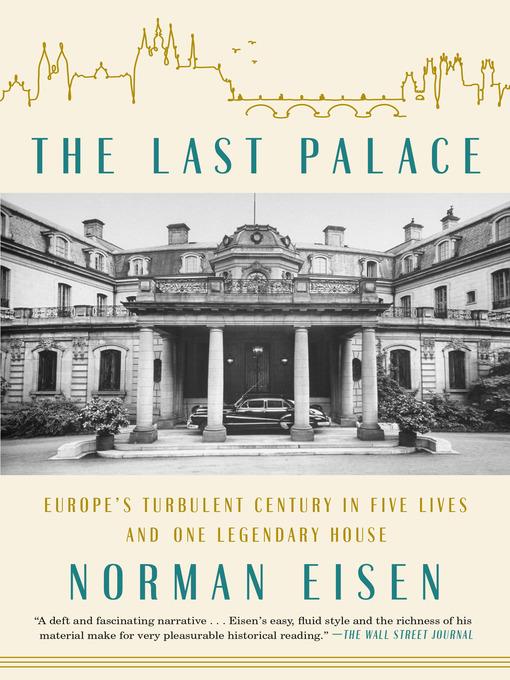
The Last Palace
Europe's Turbulent Century in Five Lives and One Legendary House
کتاب های مرتبط
- اطلاعات
- نقد و بررسی
- دیدگاه کاربران
نقد و بررسی

Starred review from July 9, 2018
In this engrossing tale by Eisen, former U.S. ambassador to the Czech Republic, the changes of 20th-century Europe are illuminated by the stories of one historic Prague building, some of its notable residents, and the author’s mother, a feisty Holocaust survivor. When Eisen, appointed to his post by President Obama, moved in 2011 into the palace of the title, now the U.S. ambassador’s residence, he was intrigued by a Nazi label on an antique table. What, he wondered, was the true story of the mansion, constructed between the world wars by Jewish coal magnate and banker Otto Petschek as an homage to European culture? Eisen’s nonagenarian mother, Frieda Grunfeld Eisen, wasn’t surprised by his finding; she survived Auschwitz, only to flee her Czech homeland as the Communists consolidated power after the war. Eisen interweaves Frieda’s story with those of Petschek and his family; Rudolf Toussaint, the conflicted German colonel who lived in the palace during the Nazi occupation; Lawrence Steinhardt, the U.S. ambassador who kept it out of Communist hands; and Shirley Temple Black, who, as ambassador beginning in the late 1980s, witnessed the end of communism. Together their stories illuminate the ebb and flow of totalitarianism, painting a picture both hopeful and disheartening. This action-packed yet lyrically written page-turner confers a fascinating human understanding of Europe’s past and present. Agent: Eric Simonoff, William Morris Endeavor.

July 15, 2018
The former ambassador to the Czech Republic tells the story of a historically significant palace in Prague.The palace, which began construction in 1924, was the project of Otto Petschek (1882-1934), a wealthy financier who left it behind when he went to study law. His family was the leading banking family in Prague, and they helped it become the 10th largest postwar economy. Not just a biography of Petschek and his mansion, Eisen's tale is also a history of Czechoslovakia, beginning with its birth in October 1918, and his family. President Woodrow Wilson, enjoying an academic friendship with Czech leader Tomas Masaryk, supported the Czech people and their closely related Slovak neighbors' bid for self-determination. The palace that Otto imagined in 1924 was designed by German architect Max Spielmann, and the estate became Otto's obsession as he ordered it to be built, redesigned, tore down, and rebuilt. His mania was such that he bought full-grown trees and an entire room--walls and all--to be shipped on flatbed train cars. But he died before World War II, and his family escaped the Nazis to London. The house suffered from Nazi and Soviet occupation as well as looting and damage before and after the war, but there were those who saw its greatness and fought to save it. Not least of these was Otto's butler, who stayed with the house through all the owners until his death, guarding what treasures he could. Eisen, a senior fellow at Brookings, also introduces us to other occupants, including Col. Rudolf Toussaint, who worked tirelessly to avoid war, and American Ambassador Laurence Steinhardt, who brokered the simultaneous withdrawal of Russian and American troops and secured the sale of the house to the State Department in return for wartime loan forgiveness. Even more interesting is the story of Shirley Temple Black, who was there for the Prague Spring in 1968 and the Velvet Revolution in 1989.A well-told story for readers interested in Czechoslovakia, its creation, its fall to fascism and then communism, and rescue from both.
COPYRIGHT(2018) Kirkus Reviews, ALL RIGHTS RESERVED.

August 1, 2018
Debut author Eisen (senior fellow, Brookings Inst.) tells the history of a remarkable mansion and its times through the eyes of its owners and guardians. The palace's architecture and interior design became an obsession for Czech industrialist and banker Otto Petschek even before he began construction in 1926. To the detriment of his family, Petschek's relationship with his children deteriorated as he pursued his vision, which completed before his death in 1934. Nazi General Rudolph Toussaint and U.S. ambassadors Laurence Steinhardt and Shirley Temple Black subsequently lived in the villa. It is through their experiences that events such as the Nazi occupation, Soviet dominance, the Cold War, the Prague Spring, and the Velvet Revolution unfold. Today the mansion and its treasures remain remarkably intact, owing to the efforts of longtime estate caretaker Adolf Pokorny and sheer luck. The experiences of Eisen's mother, Frieda, a Czech Holocaust survivor, put those of the Jewish Petscheks in perspective. When Eisen becomes U.S. ambassador to the Czech Republic, Frieda's story comes full circle. VERDICT This fascinating work will appeal especially to those interested in 20th-century history and architecture.--Laurie Unger Skinner, Highland Park P.L., IL
Copyright 2018 Library Journal, LLC Used with permission.

Starred review from August 1, 2018
When President Obama named him ambassador to the Czech Republic, Eisen found himself resident in a spectacular palace designed and built in the 1920s by Otto Petschek, a coal baron and banker and one of Prague's richest citizens. A folly of a palace, part of it was real, and part was deceptively built and decorated to appear to be made of genuine, luxurious materials. The palace both witnessed and suffered from history. First came the flight of the Jewish Petschek family from the Nazi takeover of Czechoslovakia. German general Rudolf Toussaint, more loyal to the army than to Hitler, resisted orders to burn down the palace and Prague at large. Soviet domination yielded vandalism, but the newly appointed American ambassador, Laurence Steinhardt, saved the palace from total depredation. Then the unlikely figure of Shirley Temple Black assumed control of American interests in Prague and forcefully supported the Communist dictatorship's overthrow. Eisen casts each successive caretaker of the palace as uniquely heroic and in so doing writes a wonderfully human history of twentieth-century Czechoslovakia.(Reprinted with permission of Booklist, copyright 2018, American Library Association.)

























دیدگاه کاربران